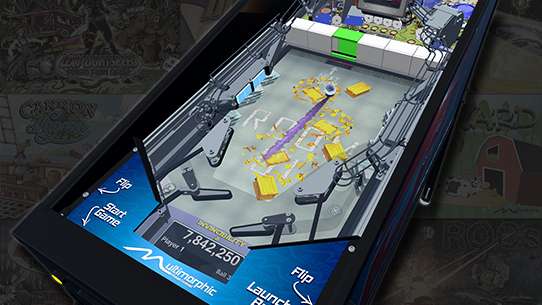
When a pinball collides with flippers,targets,or ramps at high speed,the slightest player action can change the course of the game.At such moments,even a few milliseconds of delay in the control system can turn a potentially brilliant save into a frustrating failure.The magic of pinball lies in the immediate feedback of its physical interactions,and latency is the biggest enemy of this immersive experience.
Traditional general-purpose control systems are often limited by the physical delays caused by long signal paths and dispersed components.However,Multimorphic’s P3-ROC platform takes a different approach.Through in-depth custom PCB(Printed Circuit Board)design,it has built a high-speed“nervous system”optimized specifically for pinball machines,compressing response times to the millisecond level.The core strategy lies in the complete reconstruction of signal transmission paths:
I.Signal Superhighway:From“Country Roads”to“Dedicated Networks”
Integrated design eliminates bottlenecks:The heart of P3-ROC is the high integration of key modules such as the CPU,FPGA(Field-Programmable Gate Array),drive circuits,and sensor interfaces on one or more meticulously laid-out PCBs.This completely abandons the traditional method of interconnecting different functional boards with cables and connectors.The resistance,capacitance effects,and potential poor contacts from cables and connectors are significant sources of signal delay and noise.The integrated design allows critical signals to travel at high speed on millimeter-level PCB copper traces,with extremely short paths and controllable impedance.
Layered stacking and high-speed routing:Modern high-performance PCBs typically use multi-layer structures(such as 6,8,or more layers).P3-ROC fully utilizes this feature,allocating dedicated signal layers for high-speed signals(such as sensor trigger signals and coil drive commands),providing complete ground plane shielding to minimize electromagnetic interference(EMI).The routing width,spacing,and length are precisely calculated to ensure signal integrity(SI),avoiding timing errors caused by reflections and crosstalk.The interconnection between the FPGA and surrounding chips is even more directly connected through the shortest path,achieving ultra-low latency communication.
II.Parallel Processing and Real-Time Response:The Power of FPGA
Hardware“Reflexes”:The core advantage of the P3-ROC platform lies in its FPGA.Unlike general-purpose CPUs that rely on sequential software execution,the logic circuits inside the FPGA work in parallel.For key real-time tasks in pinball machines(such as reading the status of dozens of optical sensors distributed throughout the machine,calculating the trajectory of the pinball,and deciding when and with what intensity to activate which coil),the FPGA can be configured as dedicated hardware logic circuits.These circuits can directly output drive signals the instant they receive sensor signals(at the microsecond or even nanosecond level),without waiting for CPU scheduling,achieving true“hardware-level”real-time response.Millisecond-level delays are mainly consumed in physical actions(such as coil energization and mechanical arm lifting),while the electronic processing part is almost imperceptible.
Programmable flexibility:The programmability of the FPGA allows P3-ROC to provide extreme hardware acceleration for specific tasks and adapt to changes in different pinball machine layouts and game rules by updating configurations,without the need to replace hardware.
III.The Cornerstone of Precision Manufacturing:The Support of CNC Machining
Structural stability:Although the P3-ROC platform is an electronic system,its stable operation relies on a precise mechanical structure.The racks that carry these custom PCBs,the brackets for mounting heat sinks,and the interface panels for connecting peripheral devices all require precise dimensions and stability.Large-scale metal part machining(such as base plates and support frames)ensures the rigidity of the entire control system,preventing vibrations from affecting sensitive electronic components.At the same time,precision machining of metal parts(such as precise connector mounting seats and sensor brackets)ensures accurate alignment and reliable connections of interfaces.Any slight deformation or misalignment may introduce signal interference or delay.CNC machining ensures the high precision and consistency of the mechanical parts,providing a physical foundation for the“zero latency”of the electronic system.
Heat dissipation and reliability:High-performance FPGAs and drive circuits generate considerable heat.The precision heat sinks(usually made of aluminum)or metal enclosures processed by CNC machining,with their complex fin structures and perfect contact surfaces,ensure efficient heat dissipation,preventing chips from throttling due to overheating and maintaining continuous high-performance output.
IV.Overall Optimization Beyond the Control Board
The concept of P3-ROC extends to the entire signal chain:
Sensor optimization:High-speed,high signal-to-noise ratio photoelectric sensors are selected,and their installation positions and trigger logic are optimized to reduce false triggers and delays.
Drive efficiency:The drive circuit design on the custom PCB optimizes the current rise and fall speed of coil excitation,making physical actions more rapid.
Software collaboration:The upper-level game logic runs on the CPU,communicating with the FPGA through an efficient bus.The FPGA focuses on real-time tasks with millisecond-level response,while the CPU handles game rules and display with second-level response,with clear division of labor.
Conclusion:Systems Engineering Achieves Millisecond-Level Experience
Multimorphic’s P3-ROC platform proves that solving the latency pain point in pinball machines is not as simple as upgrading a processor.It is a systematic project starting from the underlying hardware architecture:
Custom PCB as the core carrier:By using highly integrated design,multi-layer high-speed routing,and the shortest signal paths,it builds a high-speed physical channel.
FPGA as the key engine:Providing hardware-level parallel processing and real-time response capabilities,it reduces electronic processing delays to the minimum.
CNC precision manufacturing as a reliable guarantee:Precision machining of metal parts and large-scale metal part machining provide a stable,precise,and well-ventilated physical platform for the entire control system,ensuring the stable release of electronic performance.
It is this in-depth optimization of signal transmission paths and a deep understanding of the importance of precision parts in the system that enable P3-ROC to truly achieve millisecond-level response.Every hit and button press by the player can receive immediate and precise physical feedback on the pinball machine,thereby preserving the core charm of pinball games—pure and immediate control fun.